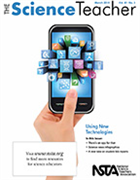Using new technologies
By Mary Bigelow
Posted on 2014-03-14
 Watching children and teenagers use computers, tablets, and smartphones, it’s easy to assume that these digital natives are very familiar with all of the new technologies. I’ve found that while they know what relates to their interests, many students are unaware of the full range of capabilities of their technology as learning tools. As the editor notes, many technological innovations have the potential to transform education. The featured articles in this issue describe some innovative ways teachers and students are using technology in science classrooms.
Watching children and teenagers use computers, tablets, and smartphones, it’s easy to assume that these digital natives are very familiar with all of the new technologies. I’ve found that while they know what relates to their interests, many students are unaware of the full range of capabilities of their technology as learning tools. As the editor notes, many technological innovations have the potential to transform education. The featured articles in this issue describe some innovative ways teachers and students are using technology in science classrooms.
Gathering information used to take a lot of time and effort, but today that information is at our fingertips. So helping students evaluate sources and interpret information becomes more important. And students are no longer limited to sharing information through traditional “reports.” The authors of two articles share their experiences in helping students develop information and media literacy by researching information and creating graphic representations and summaries. They also share resources for creating them.
- Science News Infographics describes how to do a visual read-aloud/think-aloud in which the teacher models how to interpret and question an infographic (the authors include several sources for these, in addition to other news services). The article also describes how to guide students in designing their own infographics, with examples of student projects.
- Using Infographics in the Science Classroom* includes several activities in which students analyze infographics that they find and create their own infographics on class topics. The author notes that students were intrigued by the blending of science, data visiualization, and art into a product that could be easily revised and adapted.
- If you’re looking for topics that could be discusses in infographics, see The Gray Wolf: A Good Case Study or Teens and STDs* in this issue. [SciLinks: Wolf, Wolf Population] [SciLinks: Sexually Transmitted Diseases]
Pinpointing Watershed Pollution on a Virtual Globe* has a 5E lesson that involves students in a study of their local environment. Using Google Earth and other sources, students make predictions, evaluate data, and develop inferences. [SciLinks: Watersheds]
There’s an App for That isn’t just a catchy phrase in advertising. This article is NOT a list of apps to download. The authors describe a project in which students actually designed and produced their own apps based on class topics. It’s not as complicated as it sounds—the article has a list of app design software, a rubric, and a discussion of the value of doing such a project in terms of engineering design and media literacy. What better way to understand apps than to create them yourself!
What if you could transform the traditional written lab report into a product that is engaging for both students and teachers? A New Take on Student Lab Reports describes a study in which the authors investigated the use of screencasts in which students do voice-overs of computer-based data collected during labs. They concluded that “regardless of demonstrated writing ability, students can produce clear, articulate, and careful oral explanations.” There are links to a sample student screencast and screencasting software.
The giant tomes that students carry around (and whose costs keep rising) may be a thing of the past. Textbooks 2.0 discusses digital textbooks such as the new e-Books from NSTA. Digital “textbooks” go beyond static text to include video clips, animations, simulations, online quizzes with feedback, notetaking and highlighting tools, and links to discussion forums.
*Don’t forget to look at the Connections for this issue (March 2014). Even if the article does not quite fit with your lesson agenda, this resource has ideas for handouts, background information sheets, data sheets, rubrics, etc.
Disclaimer: The views expressed in this blog post are those of the author(s) and do not necessarily reflect the official position of the National Science Teaching Association (NSTA).


